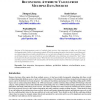Free Online Productivity Tools
i2Speak
i2Symbol
i2OCR
iTex2Img
iWeb2Print
iWeb2Shot
i2Type
iPdf2Split
iPdf2Merge
i2Bopomofo
i2Arabic
i2Style
i2Image
i2PDF
iLatex2Rtf
Sci2ools
ICIS
2004
2004
Reconciling Attribute Values from Multiple Data Sources
Because of the heterogeneous nature of multiple data sources, data integration is often one of the most challenging tasks of today's information systems. While the existing literature has focused on problems such as schema integration and entity identification, our current study attempts to answer a basic question: When an attribute value for a real-world entity is recorded differently in two databases, how should the "best" value be chosen from the set of possible values? We first show how probabilities for attribute values can be derived, and then propose a framework for deciding the cost-minimizing value based on the total cost of type I, type II, and misrepresentation errors.
Attribute Values | ICIS 2004 | Information Technology | Multiple Data Sources | Today's Information Systems |
| Added | 31 Oct 2010 |
| Updated | 31 Oct 2010 |
| Type | Conference |
| Year | 2004 |
| Where | ICIS |
| Authors | Zhengrui Jiang, Sumit Sarkar, Prabuddha De, Debabrata Dey |
Comments (0)

